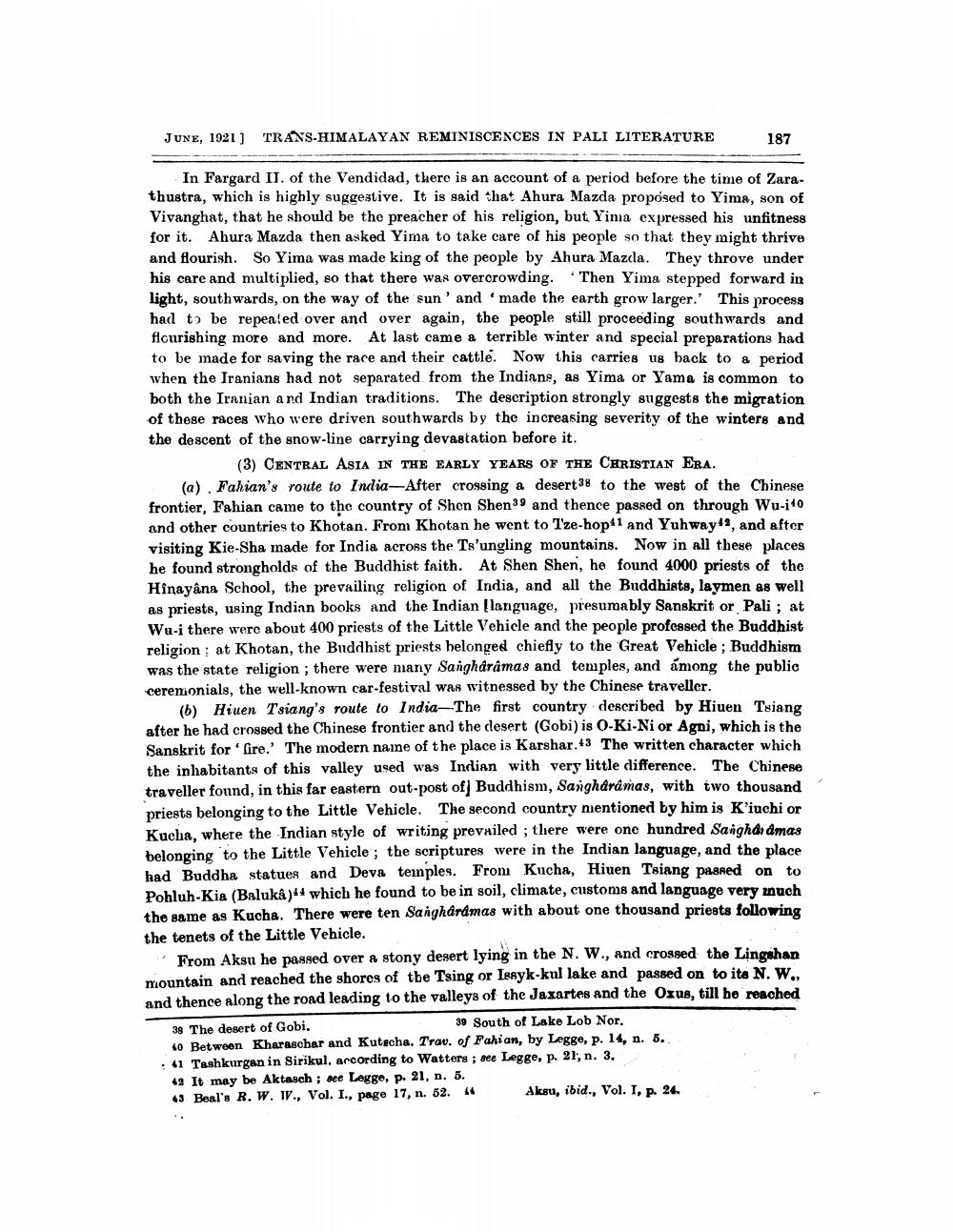________________
JUNE, 1921) TRANS-HIMALAYAN REMINISCENCES IN PALI LITERATURE
187
In Fargard II. of the Vendidad, there is an account of a period before the time of Zarathustra, which is highly suggestive. It is said that Ahura Mazda proposed to Yima, son of Vivanghat, that he should be the preacher of his religion, but Yima expressed his unfitness for it. Ahura Mazda then asked Yima to take care of his people so that they might thrive and flourish. So Yima was made king of the people by Ahura Mazda. They throve under his care and multiplied, so that there was overcrowding. Then Yima stepped forward in light, southwards, on the way of the sun' and 'made the earth grow larger.' This process had to be repealed over and over again, the people still proceeding southwards and flourishing more and more. At last came a terrible winter and special preparations had to be made for saving the race and their cattle. Now this carries us back to a period when the Iranians had not separated from the Indians, as Yima or Yama is common to both the Iranian and Indian traditions. The description strongly suggests the migration of these races who were driven southwards by the increasing severity of the winters and the descent of the snow-line carrying devastation before it.
(3) CENTRAL ASIA IN THE EARLY YEARS OF THE CHRISTIAN ERA. (a) Fahian's route to India-After crossing a desert 38 to the west of the Chinese frontier, Fahian came to the country of Shen Shen39 and thence passed on through Wu-i10 and other countries to Khotan. From Khotan he went to Tze-hop11 and Yuhway's, and after visiting Kie-Sha made for India across the Ts'ungling mountains. Now in all these places he found strongholds of the Buddhist faith. At Shen Shen, he found 4000 priests of the Hinayana School, the prevailing religion of India, and all the Buddhists, laymen as well as priests, using Indian books and the Indian [language, presumably Sanskrit or Pali: at Wu-i there were about 400 priests of the Little Vehicle and the people professed the Buddhist religion: at Khotan, the Buddhist priests belonged chiefly to the Great Vehicle ; Buddhism was the state religion ; there were many Sangharamas and temples, and among the public cerenionials, the well-known car-festival was witnessed by the Chinese traveller.
(b) Hiuen Tsiang's route to India-The first country described by Hiuen Tsiang after he had crossed the Chinese frontier and the desert (Gobi) is 0-Ki-Ni or Agni, which is the Sanskrit for fire.' The modern name of the place is Karshar.43 The written character which the inhabitants of this valley used was Indian with very little difference. The Chinese traveller found, in this far eastern out-post of Buddhism, Sangharamas, with two thousand priests belonging to the Little Vehicle. The second country nientioned by him is K'iuchi or Kucha, where the Indian style of writing prevailed; there were one hundred Sangha, dmas belonging to the Little Vehicle; the scriptures were in the Indian language, and the place had Buddha statues and Deva temples. From Kucha, Hiuen Tsiang passed on to Pohluh-Kia (Baluka) 44 which he found to be in soil, climate, customs and language very unuch the same as Kucha. There were ten Sanghårdmas with about one thousand priests following the tenets of the Little Vehicle.
From Aksu he passed over a stony desert lying in the N. W., and crossed the Lingahan mountain and reached the shores of the Tsing or Issyk-kul lake and passed on to ita N. W., and thence along the road leading to the valleys of the Jaxartes and the Oxus, till he reached 38 The desert of Gobi.
39 South of Lake Lob Nor. 40 Between Kharaschar and Kutecha. Trav. of Fahian, by Legge, p. 14, n. 6. . 41 Tashkurgan in Sirikul, according to Watters; see Legge, p. 21, n. 3. 43 It may be Aktasch; nee Legge, p. 21, n. 5. 43 Beal's R. W. W., Vol. I., page 17, n. 52.4 Aksu, ibid., Vol. I, p. 24.




